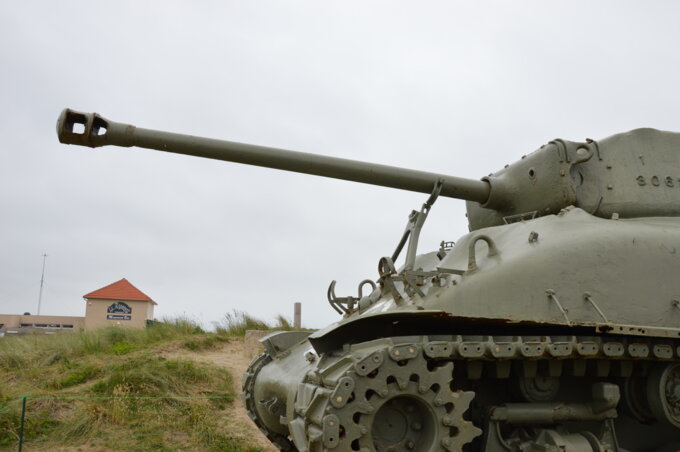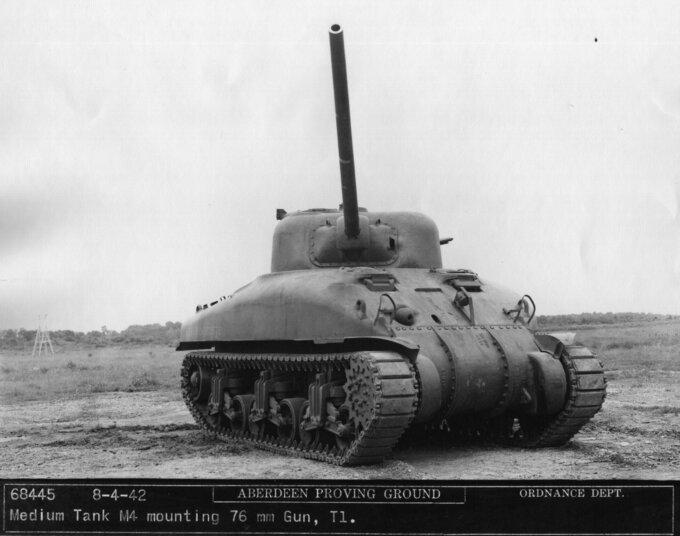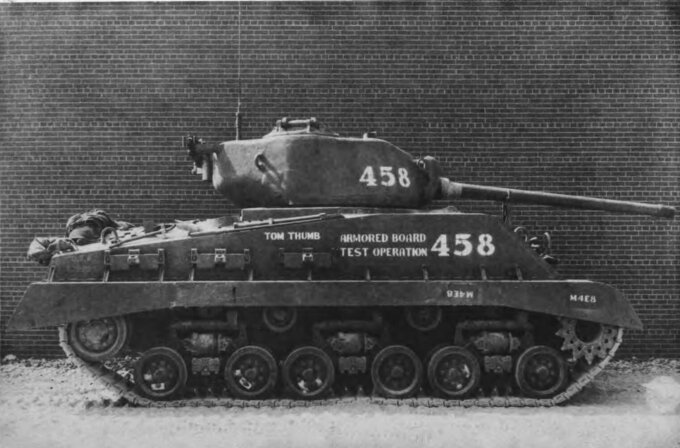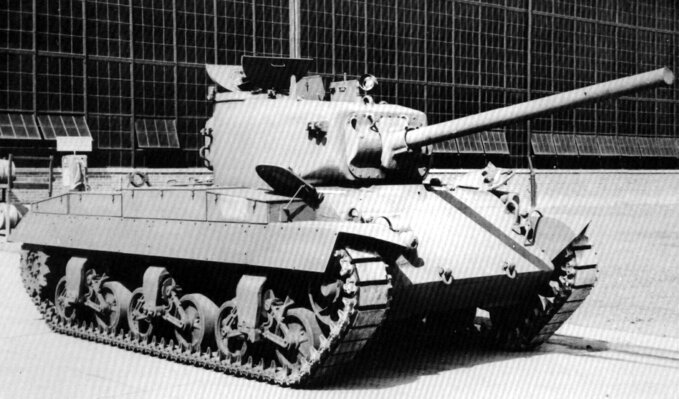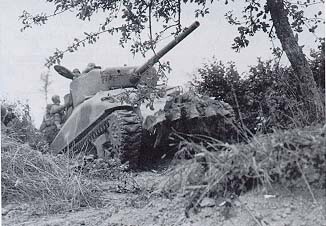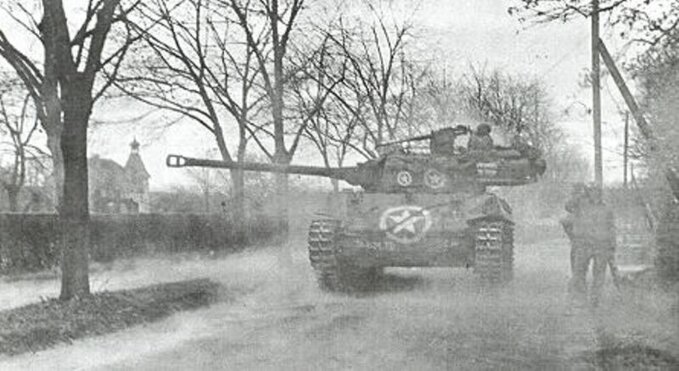While 1 mm more doesn't appear so much in size when comparing 75 mm to 76 mm, the Americans managed to make that one extra 1 mm impress with extra firepower boost against tanks during World War II. While the weapon was not without controversy on whether it was indeed the right weapon for the war, it proved sufficient in helping American tankers face-off against tougher enemy tanks to win the overall war. This is the story of how that weapon came to be.
Development of the gun
During the inter-war period, the Americans had access to the 3-inch Gun M1918 anti-aircraft gun in their inventory that fired a high-velocity 76.2 mm shell. In September 1940, it was decided to adapt the gun into an anti-tank role. Though the adaptation was a success with a towed variant and mounted on the M10 tank destroyer, it was too heavy and cumbersome for a medium tank mount. Sometime in 1942, the development of a new gun to replace the 75 mm on the M4 Sherman's mount began as the 76 mm Gun T1. It should be noted that despite the name, it has the same exact bore as the 3-inch (76.2 mm) and is only named such to avoid ammo compatibility errors between the 3-inch and the 76 mm. The developed 76 mm used a barrel lighter than the 3-inch, had the breech ring assembly of the 75 mm, and could be mounted in the Sherman's M34 mount. The gun used the same projectiles as that of the 3-inch, but a different propellant case design with enough powder to fire a round at 2,600 ft/sec muzzle velocity, identical to the 3-inch gun.
Two 76 mm T1 guns were made and shipped to Aberdeen Proving Grounds. Tests started on 01 August 1942, with one gun put on a fixed mount while the other was installed in a M4A1 turret in place of the 75 mm. Initial tests showed that the gun, 57 caliber in length, was too unbalanced. 15 inches were shaved off from the gun barrel, turning the barrel length to 52 caliber to the detriment of the anti-armor performance. Additionally, weight was added to the breech ring as a counter-weight. On August 17, Aberdeen stated the 76 mm was satisfactory inside the M4 Sherman turret. Classified as Substitute Standard, the 76 mm T1 was approved as the 76 mm Gun M1, and it was recommended that the production orders for Shermans be modified for 1,000 Shermans with the new 76 mm gun. However, General Jacob Devers from Armored Force did not approve of this plan as the Armored board had not tested the new tanks. This led to another trial period, with the 76 mm tried in the newer M34A1 gun mount using the telescopic sight in response to the Sherman's combat experience in North Africa. The same imbalance issue as previous tests arose, but this was solved by adding an 800-pound counterweight to the rear of the turret to counterbalance the barrel. Production of the tank started with 12 tanks from the Pressed Steel Car Company for evaluation by Aberdeen, Armored Board, and Tank Destroyer Board. These tanks arrived on 2 February 1943 and tests lasted until April 5th. The conclusion was that the Armored Board found the constrained space in the turret, caused by the larger gun, unsatisfactory and that the tank was a rushed "quick-fix" design and rejected the tank. This canceled the type classification and brought the 76 mm tank procurement to a halt.
Ordnance continued to tinker about with their designs and, on 03 May 1943, recommended the production of two pilots of an improved 76 mm gun mount for the Sherman. These vehicles were designated as the M4E6 and were fitted with turrets from the T23, a variant of the T20 tank series. Meanwhile, the 76 mm gun was also improved into the M1A1 variant with changes to the tube contour and a lengthened recoil surface to allow the trunnions to be moved forward for better balancing of the weapon. The two M4E6s were built by Chrysler, with one sent for evaluations at Aberdeen in July 1943 before being sent to Fort Knox for the Armored Board to take a look. The tests proved satisfactory, and on 17 August 1943, the Armored Board recommended the M4E6 be put into full production for 1,000 units, with even the possibility of completely replacing the 75 mm production with the 76 mm. The latter, however, was contested by General Alvan Gillem, who took over Devers' role in May 1943, by stating the 76 mm's flaw of a lower HE charge compared to the 75 mm (76 mm's 12.37 lbs HE shell carries only 0.86 lbs explosives whereas the 75 mm's 14.6 lbs shell carries 1.47 lbs explosives) and its tendency to create dust clouds with its muzzle blast, all for only 1 more inch of armor penetration compared to the 75 mm.
Still, 76 mm production was still in consideration and further improvements were made to the gun. The issue with the muzzle blast was solved with a new long primer ammunition that reduced the smoke left from the burning powder and the installment of a muzzle brake on the gun that diverted the muzzle blast sideways so it did not disturb the dust as much. The improvement of the muzzle brake led to the request that all 76 mm guns be fitted with a muzzle brake. 76 mm Gun M1 retooled with a threaded end for the muzzle brake were designated the M1A1C, though production of muzzle brakes for these threads did not begin until July 1944, so a thread protector covered the threads until muzzle brakes were available. The next model of the 76 mm, the 76 mm Gun M1A2, featured more improvements. The rifling on the gun was tighter, with one turn per 32 caliber rather than one turn per 40 caliber on previous models, which helped improve ballistics at longer ranges. Every M1A2 design also had a muzzle brake attached.
Combat usage
The first batch of 130 M4A1 (76) Shermans were sent to Britain on 10 April 1944, but despite their presence and even reports at the Italian Theater facing some of Germany's newer vehicles like the Panther, they were not sent to Normandy on the onset of D-Day. Major General Hugh Gaffey of the 2nd Armored Division advocated for this decision as there were only so few of them available, the troops were not properly trained on the new tank gun, and the logistic situation would be a mess to supply the new ammunition. As such, it was proposed by General W.B. Palmer that the 76 mm be delayed for tank battalions and only specified for such battalions rather than intermingling the 76 mm and 75 mm in mixed units. Either way, not one 76 mm Sherman landed in France in June 1944. Even attempts to interest the US Third Army on 12 June 1944 fell short as a report went, "All of the commanders were reluctant to see it take the place of the 75 mm tank gun in any quantity". The reason for this desire to keep around with the 75 is the belief that the 75 mm could still do the job defeating enemy armor as the newer tanks, like the Tiger I since Tunisia, have been handled with the 75 mm cannon. Even the Panther was not taken seriously as it was believed that Panther was a specialized heavy tank allocated in small numbers. It was not until Normandy that the U.S. fighting forces would experience firsthand how numerous the Panthers were.
By June 1944 in Normandy, criticism from tankers on the ineffectiveness of the 75 mm on the new Panthers came to light. On July 2, Eisenhower relayed the complaints to Ordnance, and on July 12, a board was created to determine what weapons were available that could defeat the Panther. The board determined after tests that none of the U.S. standard weapons could defeat the Panther from the front, and the 3-inch on the M10 could only do so on the gun mantlet from 200 yards out. Suddenly, the 76 mm Shermans sitting idly in Britain became very sought out, and General Bradley of the 1st US Army ordered as many of the 76 mm Shermans be sent into France for Operation Cobra. 102 M4A1 (76) tanks arrived in France and became a key part of the operation, marking their combat debut on 25 July 1944 , the second day of the operation. The success of the operation helped vindicate the relevance of the 76 mm Sherman and new 76 mm tank models on the M4 and the M4A3 soon arrived in September 1944. However, the 76 mm Shermans, now combat tested, ended up in another pitfall when they still proved ineffective against the Panther's front. Eisenhower, when hearing of the issue, remarked on the predicament:
You mean our 76 won't knock these Panthers out? Why, I thought it was going to be the wonder gun of the war. Why is it that I'm the last to hear about this stuff? Ordnance told me this 76 would take care of anything the Germans had. Now I find you can't knock out a damn thing with it.
In August 1944, an improved ammunition for the 76 mm started to come in, the T4 (M93) HVAP ammo. The tungsten ammunition could penetrate the Panther on the mantlet up to 1,000 yards out. 2,000 of the new HVAP ammo arrived by air in August 1944. Though 20,000 were ordered, the supply was never able to keep up with the demand. By February 1945, the average 76 mm tank has received a total of five HVAP rounds, meaning an acquiring rate of one HVAP per month a tank. A total of 18,000 HVAP came to Europe by March 1945, with 42% of the total being for the 76 mm and the rest for the 3-inch gun.
The Battle of the Bulge turned a few heads for the 76 mm. Before that, German armor was only experienced in sporadic situations, with minor counter-offensives in events like the Battle of Arracourt. There were divided feelings about the 76 mm due to its decreased HE performance compared to the 75 mm, and that the 75 mm has specialized ammo like the white phosphorus round that the 76 did not have. Thus, proposals to completely replace the 75 with the 76 were met with objections. But after the Battle of the Bulge, the criticism changed to the inadequacy of the 75 mm against German tanks like the Panther and the heavier Tiger II. 12th US Army Group on 29 January 1945 even requested that all US tanks that arrive in Europe be the 76 mm version, refusing any more 75 mm Shermans.
The 76 mm faced more than a fair share of criticism throughout its life. Promised to give a bigger punch than the 75 mm, it fell short with changing times against improving German armor as it was designed with a mindset of German armor in 1942. Still, as a tank gun, the 76 mm did its job as best it could against the opposition, and was still overall a better gun in several respects than after the war, the 76 mm was retained on the M4A3E8 Sherman. In the 1950s in the Korean War, the 76 mm still proved adequate against the Soviet T-34-85 and no complaints were made on the Sherman's role as an infantry support during the latter stages of the war. Though, as the armament of the evolving U.S. tank force, the 76 mm Gun M1 was succeeded by the much bigger and better 90 mm that would be the armament of the M26 Pershing and its M46, M47, and M48 successors.
Bibliography
- Hunnicutt, R.P. ''Sherman: A History of the American Medium Tank'' U.S.A.: Feist Publications, 1978
- Hunnicutt, R.P. ''Pershing: A History of the Medium Tank T20 Series'' U.S.A.: Feist Publications, 1971
- Zaloga, Steven. ''M4 (76mm) Sherman Medium Tank 1943-65'' Great Britain: Osprey Publishing Ltd., 2003
- Zaloga Steven. ''T-34-85 vs M26 Pershing: Korea 1950'' Great Britain: Osprey Publishing Ltd., 2010
